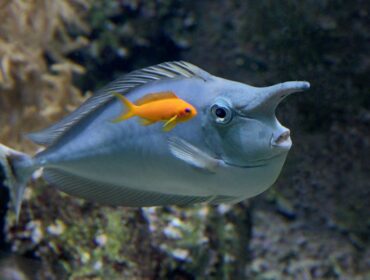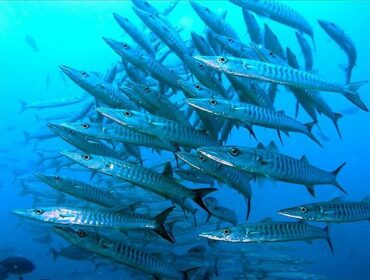Clownfish also known as anemonefish are native to the warmer tropical waters of the Indo-pacific and are simply a divers delight to watch. Wherever you spot sea anemone, chances are that a family of clownfish are probably sheltered in it. Even though most clownfish are instantly recognizable as clownfish, determining the variety of clownfish is challenging for even the more seasoned divers. With twenty eight different varieties of clownfish, it is no wonder why it is often difficult for divers to correctly identify the variety of clownfish. We have put together a two part basic Clownfish Identification guide that should help you more easily recognize these delightful fish.
Pink Skunk Clownfish
Also known as the False Skunk-striped Anemonefish, the Pink Skunk Clownfish is instantly recognizable by its pink to peach-orange base color with one white stripe that runs from the nose and down the entire length of the back. Just behind its eyes it has another white stripe that runs vertically. The Pink Skunk Clownfish is generally a smaller variety of clownfish and grows to a length of around 3.9 inches. They are found primarily in the western pacific or eastern Indian Ocean.
Tomato Clownfish
Also known as the Red Clownfish or Bridled Clownfish, these fish are found throughout the Pacific and usually amongst the Bubbletip Sea Anemone which makes it easy to find. The Tomato Clownfish is a bright orange-red with one white vertical stripe behind the eye and can grow to 5 inches in length.
Ocellaris Clownfish
Known also as the False Percula Clown, these fish are often mistaken for the Percula Clownfish as the color pattern is similar but not as bright as the Percula. The Ocellaris is perhaps one of the most instantly recognizable of clownfish the fish and featured in the animated film “Finding Nemo” as the lead character Nemo. It has an orange body color with three white vertical stripes on its body and black tips on the fins. Ocellaris also come in a black variety with no orange which make a striking contrast against the white stripes. Ocellaris can grow up to 8 inches in length.
Percula Clownfish
Also known as the true Percula Clownfish or Clown Anemonefish these fish are similar in appearance to the Ocellaris with its orange base and three white vertical stripes. However Percula Clownfish have a bright orange color, thicker black outlines, and do not exceed 4.5 inches in length. Percula’s are also distributed throughout the Indo-Pacific and are common residents of reefs in this region.
Part 2 of the article ‘Clown Fish Identification’ continued here.



